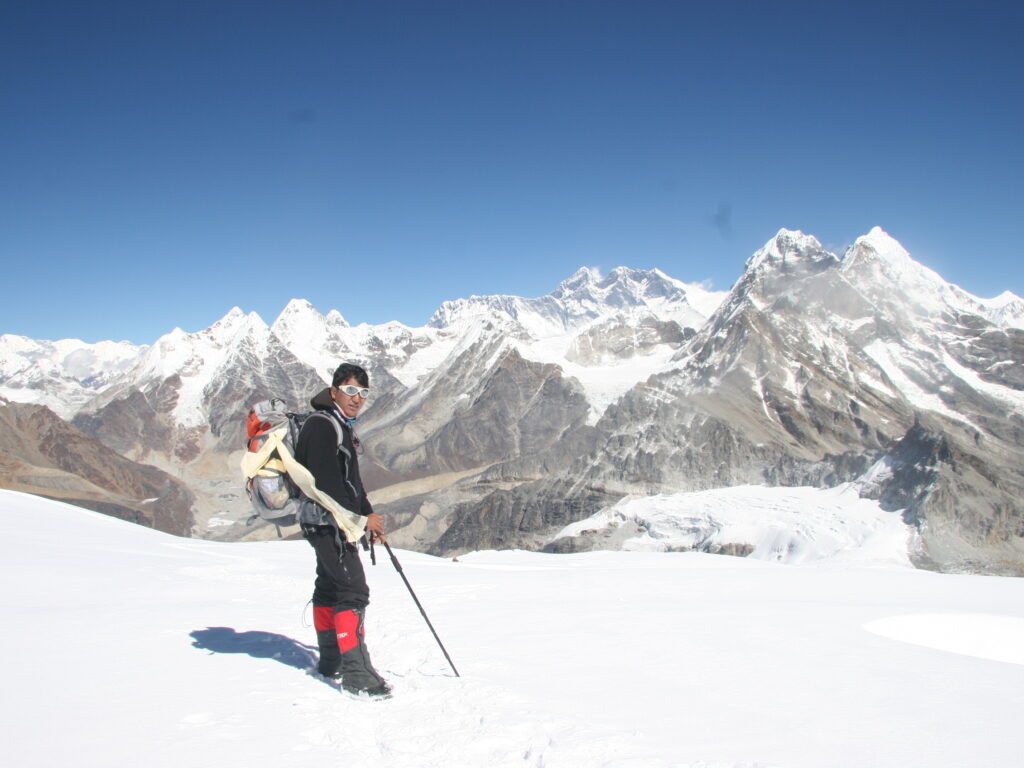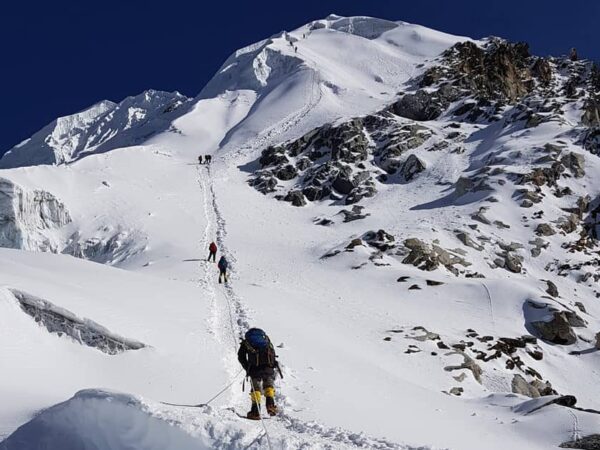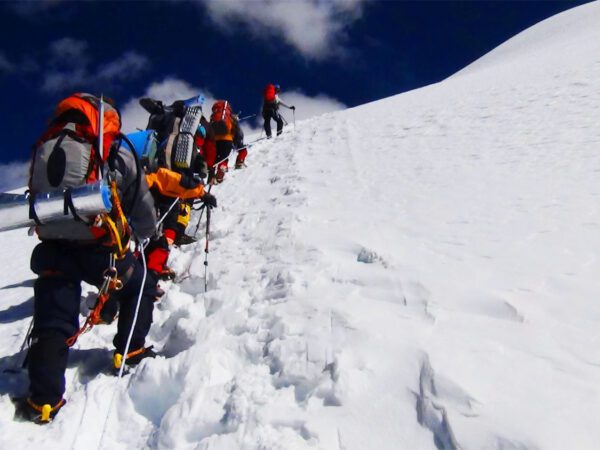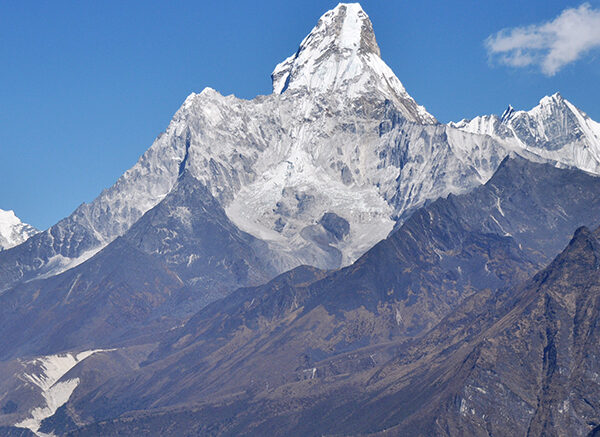Why us?
- Expertise & Experience
- Personalized & Flexible Itineraries
- Local Native Guides
- Competitive Pricing Without Compromising Quality
- Guaranteed Departure
- Top-notch Service
- Hassle-Free Permits & Logistics
- Small Groups for a Better Experience
- Safety First Approach
- Eco-Friendly & Sustainable Travel
- Exceptional Customer Service
- Community Support & Ethical Tourism
Highlights
- Embark on an exciting adventure to stand atop Mera Peak, Nepal’s highest trekking peak, with breathtaking views of the world’s tallest mountains.
- Explore the hidden and scenic Hinku Valley, an untouched gem in the undisturbed areas of the Khumbu region.
- Journey along off-the-beaten paths, immersing yourself in the tranquility of pristine mountain wilderness far from bustling villages.
- Camp under starry skies at high-altitude base camps, surrounded by towering peaks and serene alpine landscapes.
- Experience the thrill of ascending through diverse terrains, from lush green valleys to snow-covered summits.
- Connect with local Sherpa guides and porters, learning about their rich culture, traditions, and mountaineering expertise.
Overview
Mera Peak is an inimitable trekking peak for novice adventurers although the peak is 6476 m high from the sea level. At this altitude, the air contains a low level of oxygen what it lies on sea level. So, we don’t recommend you to Mera Peak Climbing if you have not hiked above 3000 m altitude before. But it does not require high mountaineering skills.
Hundreds of climbers visit the Khumbu region to summit the peak every year. From the summit of the Mera Peak, the stunning view of the world’s 4 tallest mountains can be enjoyed.
The Mera Peak follows a separate route as it does not go through Namche although all the treks of Khumbu pass through Namche Bazaar. It literally means this trip takes you away from Everest crowds, while you will approach the beautiful Arun valley. Meanwhile, you will also see local farming terraces and their living styles.
The Mera Peak itinerary below is carefully designed to have proper acclimatization with steady walk.
Outline Itinerary
Day 01: Arrival in Kathmandu (1,300m/4,264ft)
Day 02: Kathmandu: trip preparation or sightseeing (optional)
Day 03: Fly to Lukla, trek to Paiya (Chutok) (2,730m/8,956ft): 40 mins flight, 5-6 hours trek
Day 04: Paiya to Panggom (2,846m/9,337ft): 5-6 hours
Day 05: Panggom to Ningsow (2,863m/9,393ft): 4-5 hours
Day 06: Ningsow to Chhatra Khola (2,800m/9,186ft): 7-8 hours
Day 07: Chhatra Khola to Kothe (3,691m/12,109ft): 6-7 hours
Day 08: Kothe to Thaknak (4,358m/14,297ft): 3-4 hours
Day 09: Thaknak to Khare (5,045m/16,486ft): 2-3 hours
Day 10: Khare: Acclimatization and pre-climb training
Day 11: Khare to Mera High Camp (5,780m/18,958ft): 6-7 hours
Day 12: Mera High Camp to Summit (6,461m/21,1907ft) and back to Khare (5045m/16,547ft): 8-9 hours
Day 13: Reserve Day for Contingency
Day 14: Khare to Kothe (3600m/11808ft): 4-5 hours
Day 15: Kothe to Thuli Kharka (4,300 m/14,107ft): 5-6 hours
Day 16: Thuli Kharla to Lukla via Zatrwa La pass: 6-7 hours
Day 17: Fly to Kathmandu
Day 18: Final departure
Lodging and Fooding
Tea House is the only option where you get meals and accommodation while you are on the way to climbing Mera Peak. Indeed, there is no luxurious hotel in the region, whereas, you will stay at a hotel in Kathmandu.
Tea House serves both the foods and accommodation to the trekkers and climbers. In a tea house, you will stay in the twin-shared room as it is hard to get a single room in the mountain. But sometimes it is possible to get a single room by paying an additional amount.
In the tea houses, you often get limited meal options to choose from. You can taste Nepali foods, Indian Continental as well as continental cuisine. If you go through any tour operator, most of them provide one menu item only.
Mera Peak Climbing Difficulty
Mera Peak is a trekking peak. It literally means that Mera Peak does not require a high level of climbing experience. If you want to climb Mera Peak, you need to be physically fit and have some hiking experience. However, rope using technique and climbing experience is worthwhile while climbing the peak.
Best time to Climb Mera Peak
Basically, Mera Peak climbing is supposed to be perfect for Autumn and Spring seasons because weather and climate used to be suitable for trekking and climbing in the mountains of Nepal. For more detail about climate and weather, you can log in to our article the best season to travel in Nepal.
Physical Fitness for Mera Peak Climbing
Mera Peak (6,476m) is a high-altitude climb requiring excellent physical fitness and endurance. The ascent involves long trekking days, glacier travel, and a final summit push in icy conditions. Climbers should be prepared for 6-8 hours of daily trekking at altitudes exceeding 5,000 meters, with steep ascents, technical sections, and the use of mountaineering equipment like crampons and ice axes.
To prepare, begin training at least four months in advance. Focus on aerobic exercises (running, swimming, cycling) and strength training (leg and core workouts). Simulating high-altitude conditions by hiking with a loaded backpack will help build stamina and prepare you for carrying gear in thin air. Prior trekking experience at high elevations is recommended for a successful climb.
Typical Climbing Day
A day on Mera Peak follows a structured routine to ensure proper acclimatization and energy conservation:
- 6:00 AM: Morning tea, packing up gear
- 8:00 AM: Start trekking/climbing
- 11:30 AM: Lunch break and short rest
- 3:00-4:00 PM: Arrival at teahouse or campsite
- 7:00 PM: Dinner, briefing, and preparation for the next day
The summit day typically begins at midnight to take advantage of stable snow conditions, with climbers reaching the top by sunrise and descending safely before afternoon weather changes.
Meals & Accommodation on the Trek
Accommodation during the trek is in teahouses, while base camp and high camp involve tented camping. Teahouse rooms are basic, with shared bathrooms and limited electricity for charging devices. In the higher sections, climbers will stay in expedition tents.
Common meals include:
- Dal Bhat (rice, lentil soup, vegetable curry) – high in energy
- Porridge, eggs, chapati, and tea for breakfast
- Pasta, noodles, soups, and seasonal vegetables
- High-altitude foods such as dried fruits, energy bars, and hot drinks
Dining tents are set up at base camp, providing warmth and a communal space for climbers to eat and rest.
Managing Internal Flight Delays in Nepal
Flights to Lukla, the gateway to Mera Peak, are often delayed due to unpredictable weather. To minimize disruptions:
- Plan extra buffer days before and after your climb.
- Consider a helicopter alternative ($350 – $650 per person, depending on group size).
- Ensure your travel insurance covers flight delays and alternative transport.
Travel Insurance for Mera Peak Climbing
Travel insurance is mandatory for Mera Peak climbers. Your policy must cover:
- Emergency evacuation (helicopter rescue)
- Medical expenses at high altitude
- Trip cancellations and delays
- Lost or stolen baggage
Verify that your policy covers climbing up to 6,500m, as standard trekking policies may not include mountaineering activities.
Nepal Visa Entry Procedure
Most travelers can obtain a visa on arrival at Tribhuvan International Airport (TIA) or at land border checkpoints. Visa fees are:
- 15-day single entry: $30
- 30-day single entry: $50
- 90-day multiple entry: $125
A passport valid for at least six months, cash in USD, and passport-sized photos are required for visa processing. Check the Nepal Department of Immigration website for updates.
Acute Mountain Sickness (AMS) & Prevention
AMS can occur above 3,000m, with symptoms like headache, nausea, and dizziness. To prevent AMS:
- Follow a gradual acclimatization schedule with planned rest days.
- Stay hydrated and avoid alcohol.
- Ascend slowly and sleep at lower altitudes after reaching higher points.
- If symptoms persist or worsen, descend immediately.
Our guides carry oxygen cylinders and satellite phones for emergency communication, ensuring your safety at all times.
Drinking Water Safety
To avoid waterborne illnesses, always purify your drinking water:
- Avoid tap water (even for brushing teeth).
- Buy sealed bottled water when available.
- Use water purification tablets, filters, or UV sterilizers.
- Boiled water is available at teahouses and campsites—ask your guide for the safest option.
Arrival Instructions
Upon arrival at Tribhuvan International Airport (TIA), our representatives will greet you with a sign bearing your name. They will assist with luggage and transfer you to your hotel in Kathmandu. Avoid unofficial porters and keep valuables secure.
For a safe and unforgettable Mera Peak adventure, we provide expert guides, well-planned itineraries, and seamless logistics. Contact us today to start planning your climb!
Mera Peak Climbing – 18 Days - Itinerary
Arrival in Kathmandu (1,300m/4,264ft)
Kathmandu: trip preparation or sightseeing (optional)
Fly to Lukla, trek to Paiya (Chutok) (2,730m/8,956ft): 40 mins flight, 5-6 hours trek
Paiya to Panggom (2,846m/9,337ft): 5-6 hours
Panggom to Ningsow (2,863m/9,393ft): 4-5 hours
Ningsow to Chhatra Khola (2,800m/9,186ft): 7-8 hours
Chhatra Khola to Kothe (3,691m/12,109ft): 6-7 hours
Kothe to Thaknak (4,358m/14,297ft): 3-4 hours
Thaknak to Khare (5,045m/16,486ft): 2-3 hours
Khare: Acclimatization and pre-climb training
Khare to Mera High Camp (5,780m/18,958ft): 6-7 hours
Mera High Camp to Summit (6,461m/21,1907ft) and back to Khare (5045m/16,547ft): 8-9 hours
Reserve Day for Contingency
Khare to Kothe (3600m/11808ft): 4-5 hours
Kothe to Thuli Kharka (4,300 m/14,107ft): 5-6 hours
Thuli Kharla to Lukla via Zatrwa La pass: 6-7 hours
Fly to Kathmandu
Final departure
Inclusions
What's included
- Airport transfers - pickup and drop off
- Hotel in Kathmandu with breakfast included
- Experienced English-speaking guide and porter
- A Climbing guide
- Trekking permits, Climbing permits, Makalu National park permits
- 3-star hotel in Kathmandu for 3 nights (bed and breakfast)
- Food and accommodation, including tea/coffee, during the trek
- Camping tent and kitchen staff during camping
- Private vehicle for Kathmandu Sightseeing
- Flight tickets from Kathmandu to Lukla and back
- Satellite phone
- Medical kit
- Guide and porter insurance food and Accommodation
- Sleeping bag, duffle bag, Down jacket and trekking poles
- Climbing Equipment During climbing time
What's not included
- International flight ticket
- Nepal visa fee
- Personal medical /travel insurance
- Guide and porter tips
- Personal equipment
- Personal bill
- Kathmandu lunch/dinner
Equipment
Preparation of equipment and packing list is essential which can't be forgotten. Basically, the packing list and equipment for Mera Peak Climb are similar to the other trekking peaks of Nepal. As such, you can use ditto gears that are suggested to climb the Island Peak.
Basic types gears for Mera Peak Adventure:
-
- Trekking Gears
- Climbing Gears
The most essential climbing gears are given below:
-
- Ice axe
- Crampons
- Harness
- Helmet
- Climbing boot













